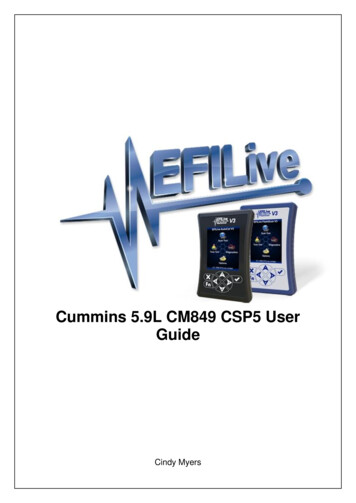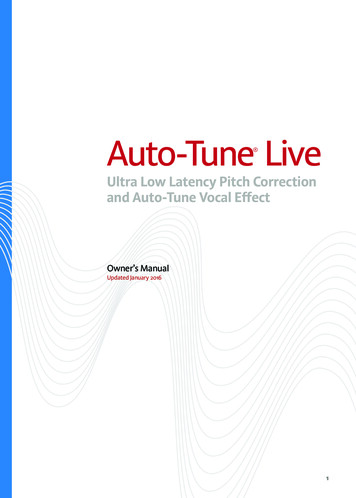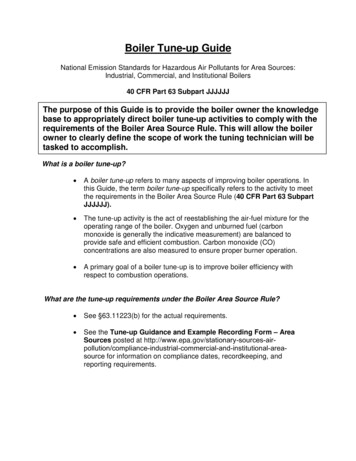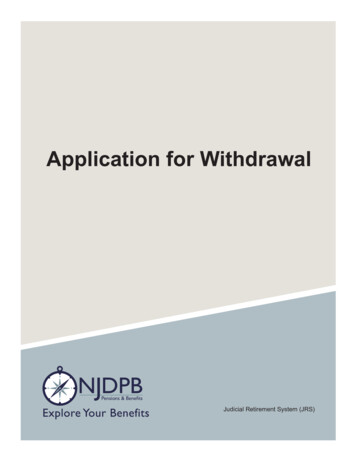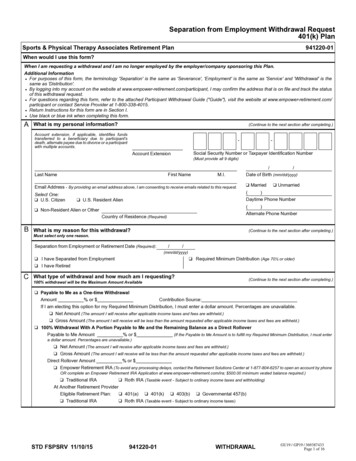
Transcription
FINE-TUNE YOURRETIREMENTWITHDRAWALSTRATEGY
Toincreasethelikelihoodyourretire-ment savings will last your lifetime, trategy.Takeretiretimebefore retirement to accurately calculate yourretirement income need. You will also need toidentify your retirement surplus or shortfall tofully assess if you are financially prepared forretirement. GuideStone can help you evaluateyour retirement income need and develop apersonalized retirement solution that worksbest for you.
1231 STEP ONE:STEP ONE: Calculate Your Retirement Income Need.STEP TWO: Calculate Your Surplus or Shortfall.STEP THREE: Understand and Choose Your Retirement Solution.Calculate Your Retirement Income Need.Calculate your monthly expenses and consider categorizing them into essential and non-essentialwell in advance of retirement.What are your expenses?Retirement expenses include everything from housing, food and utilitiesto transportation, taxes and medical expenses. Remember, it’s importantto take inflation and increased costs into consideration — especially inregard to medical visits/procedures which may increase with age.RULE OF THUMBFor a quick estimate, financial plannerssuggest replacing 70%–90% of your finalworking year’s income, but knowing youractual expenses is preferable.What are your lifetime income sources?The most common sources of lifetime income streams outside of retirement savings (i.e., 403(b), 401(k), IRAs, etc.) include: Social Security (visit SSA.gov/MyAccount to access your statement)Annuities, pensions and other lifetime incomeWhat is your retirement income need?To identify your monthly retirement income need, simply subtract your monthly lifetime income sources from your retirement expenses(essential and non-essential):Retirement Income NeedIf the expenses are more than your lifetime income, this figure is your retirement income need (i.e., the amount of expensesthat you will not be able to cover with your lifetime income). This is the amount of additional retirement income needed from yourretirement savings (i.e., employer-sponsored 403(b) and 401(k) plans, IRAs and personal savings) to maintain your current standardof living.
2 STEP TWO:Calculate Your Surplus or Shortfall.In order to calculate your surplus or shortfall, knowing your sustainable withdrawal rate isparticularly important. If you withdraw too much during retirement, you could run the risk ofdepleting your assets before the end of your life (longevity risk).What is your sustainablewithdrawal amount?In order to develop a sustainable strategy, you need tocalculate a monthly sustainable withdrawal amount. Thewithdrawal rates shown below are, based on your ageat retirement, the maximum amount that should be withdrawn per year. If you are married, the youngest spouse’sage should be referenced.3 Based on the appropriate ratelisted below, calculate a sustainable withdrawal amountfrom your retirement savings (i.e., employer-sponsored403(b) and 401(k) plans, IRAs and personal savings, such asinvestment accounts, savings accounts and CDs).Retirement AgeSustainable Withdrawal Rate59 or less3.50%60–654.00%66–694.50%70 and overGreater of 5% or RMDDo you have a surplus or shortfall?Subtract your earlier calculated retirement income need from your sustainable withdrawal amount. If this number is negative,then you have a shortfall, meaning your retirement income need is not completely covered by your sustainable withdrawalamount. Before proceeding, you may need to consider:1.2.3.4.Reducing your retirement expenses starting with non-essential expensesContributing more to your retirement savings plans before retirementWorking longer, and perhaps even into retirementReviewing your retirement income solutionsIf this number is positive, then you have a surplus, and your sustainable withdrawal amount completely covers your income need.You’re able to move forward to Step 3 to determine the appropriate withdrawal solution(s).
3 STEP THREE:Understand and Choose Your Retirement Solution.Based on your individual preferences, consider these options to make withdrawals from youremployer-sponsored plans, IRAs and/or personal savings:Life Income AnnuityThis option provides monthly income payments for the rest of your life or the lives of both you and your spouse (if named joint lifeapplicant). Once you’ve made this decision, you cannot change your withdrawal strategy. This lifetime payout option provides easeof mind, as you know that part of your retirement income will last for the rest of your life, reducing longevity risk. Keep in mindthat in purchasing a life income annuity you may trade all or a portion of your invested retirement balance for a lifetime streamof income.Systematic WithdrawalThis option provides flexible income that you can change at any time. Payments are sent to you on a regular basis (such as monthly). You retain responsibility for investing your retirement account balance. Using the calculated sustainable withdrawal rate helpsyou establish an adequate withdrawal payment per month. Each year, you can increase your withdrawal amount to adjust forinflation (if needed). Keep in mind that, depending on market volatility and/or if you withdraw more than a sustainable amount,you increase your longevity risk.Combining Income SolutionsChoosing a life income annuity in combination with a systematic withdrawal can help meet different expenses over time. A lifeincome annuity is most useful for paying essential expenses. Whereas, a systematic withdrawal is best for paying non-essentialexpenses.For a better understanding of your retirement withdrawal strategy, turn to the back page for a working example.GuideStone is here to help you with your retirement planning needs. Understanding your retirement income need, your surplusor shortfall and available withdrawal solution can help you develop an appropriate withdrawal strategy and minimize the risk ofoutliving your assets. Plan ahead and protect your financial future by making informed withdrawal decisions.To learn more about retirementincome withdrawal strategiesthat are right for you, contactGuideStone at 1-888-98-GUIDE(1-888-984-8433).
EXAMPLEA married couple, both age 64, looking to retire immediately, has 170,000 in his403(b) and 100,000 in her IRA for a combined savings of 270,000.They establish that their monthly essential expenses are 3,700 and monthly non-essentialexpenses are 100, making total retirement expenses 3,800.Their lifetime income source is as follows: They are scheduled to receive retirement incomeof 2,800 at age 64 ( 2,100 for Social Security and 700 for her pension). Alternatively, ifthey waited one year, their retirement income would increase to 3,100 at age 65 ( 2,275for Social Security and 825 for her pension).Their sustainable withdrawal rate is 4%, since they are within the 60–65 sustainablewithdrawal rate age band.To determine their withdrawal strategy:Patricia J. Purcell, Income Replacement Ratios in the Health and Retirement Study, U.S. Social Security Administration Office ofRetirement and Disability Policy, (2012), l Security Administration: 2016 Life Expectancy Data, accessed May 18, 2016, SSA.gov/planners/lifeexpectancy.html.2Sustainable withdrawal rates based on summary of research by Kitces and Otar’s sustainable withdrawal rate research andmodels. 20 Years of Safe Withdrawal Rate Research, Michael Kitces, March 2012. Compendium of Sustainable Withdrawal Rates, Part I, Jim Otar, September 2014.3This is for informational purposes only. This is not intended to be indicative of an actual annuitant scenario. This annuity exampleis based on a spousal couple both age 65 selecting a GuideStone Financial Resources 100% Joint Life Income Annuity with GuideStone’s annuity funding rate as of October 2016. Call to request a personal retirement income estimate.4
1STEP ONE: Calculate Your Retirement Income Need.First, they calculate their retirementincome need of 1,000.Retirement Expenses– Lifetime Income Sources 3,800 2,800Retirement Income Need2STEP TWO: Calculate Your Surplus or Shortfall.Second, they calculate their shortfall of 100.Subsequently, they decide to wait one yearto retire at age 65. Then they calculate theirretirement income need of 700 as well astheir surplus of 300.Please note, in addition to working a yearlonger, they continue to contribute to the403(b) and IRA. Although this exampledoesn’t show expense increases, you shouldconsider that expenses can increase due toinflation when choosing your withdrawalstrategy.3 1,000Retirement Income Need– Sustainable Withdrawal Amount 1,000 900(4% of 270,000 divided by 12)ShortfallRetirement Expenses– Lifetime Income SourcesRetirement Income Need 100(Unsustainable) 3,800 3,100 700– Sustainable Withdrawal Amount 1,000(4% of 300,000 divided by 12)Surplus 300(Sustainable)STEP THREE: Understand and Choose Your Retirement Solution.Then, they develop a combination of solutionsto meet their preferences/needs:Of their 700 retirement income need, theyplan to: Cover 600 per month (essentialexpenses) with an annuity Pay the remaining 100 per month(non-essential expenses) with asystematic withdrawalConclusion: This combination of solutions providesadequate income to maintain their standard of living, reduces longevity risk, provides liquidity for nonessential and unplanned expenses and increases theiropportunity to leave legacy assets for their beneficiaries.To do so, they:1. Annuitize 140,000 of their retirement assets for the 600 per month42. Leave the remaining 160,000 available for their systematic withdrawal of 100 permonth, which is also a sustainable withdrawal because it’s less than the 4% sustainablerate for their ageIn this example, the couple is most concerned about longevity risk and would like their lifetime income to meet essential retirement expenses; theyalso desire money to be available for non-essential expenses.
2016 GuideStone Financial Resources26774 244109/16
To learn more about retirement income withdrawal strategies that are right for you, contact GuideStone at 1-888-98-GUIDE (1-888-984-8433). For a better understanding of your retirement withdrawal strategy, turn to the back page for a working example.

